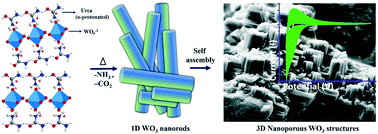Designing a 3D nanoporous network via self-assembly of WO3 nanorods for improved electrocapacitive performance†
Abstract
This work presents the first report on effective utilization of protonated urea as a novel nanostructure directing agent, under controlled conditions of pH, calcination temperature and time, to design 3D WO3 nanoporous networks using self-assembly of WO3 nanorods. The synthesized nanostructures are characterized for their phase purity, shape, size and morphology using various surface characterization techniques. The effect of nanostructure design and dimensionality on improved electrocapacitive performance is investigated by measuring the H+ intercalation efficiency using cyclic voltammetry. The highest H+ diffusion coefficient of 1.3 × 10−7 cm2 s−1 and specific capacitance of 148 F g−1 are measured for 3D WO3 nanoporous structures. The improved electrocapacitive performance is attributed to the 3D surface heterostructure and the presence of well aligned porous channels, which together provide facile diffusion of H+ ions and a greater electroactive surface area. The simplicity and flexibility of the synthesis method to produce multidimensional WO3 nanostructures of improved electrocapacitive performance demonstrate promising results for device scale applications.



 Please wait while we load your content...
Please wait while we load your content...